Regions
Weißkugel Range, Western Verwall Mountains, Gurgler Range, Central Stubai Alps, Eastern Verwall Mountains, Allgäu Alps, Silvretta, Samnaun Mountains, Eastern Lechtal Alps - Ammergau Alps, Northern Oetz and Stubai Alps, Mieming Mountains, Karwendel Mountains, Western Lechtal Alps, Central Lechtal Alps, Glockturm Range, Grieskogel Mountains
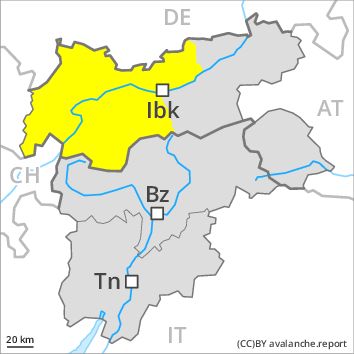
Danger level
Danger Level 2 - Moderate above the treeline
Danger Level 2 - Moderate above the treeline
Avalanche Problem
Wind-drifted snow above the treeline, N-NE-E-SE-S-SW-W-NW
Persistent weak layer above the treeline, N-NE-E-SE-S-SW-W-NW

The fresh and somewhat older wind slabs represent the main danger.
As a consequence of fresh snow and wind the wind slabs have increased in size once again in the last three days. The avalanche-prone wind slabs of the last three days are prone to triggering in all aspects and generally above the tree line. The avalanche prone locations are to be found especially on wind-loaded slopes. More frequent dry slab avalanches are to be expected. They can also be released in the old snowpack and reach medium size in isolated cases especially on shady slopes.
Snowpack
dp 6: cold, loose snow and wind
dp 1: deep persistent weak layer
Over a wide area 5 to 15 cm of snow, and even more in some localities, fell in all altitude zones. The northerly wind will transport the fresh snow and, in some cases, old snow as well. Over a wide area sometimes avalanche prone wind slabs formed. The fresh snow and wind slabs of the last three days will be deposited on the unfavourable surface of an old snowpack in particular on shady slopes above the tree line. Faceted weak layers exist in the snowpack in particular here.
Tendency
Gradual decrease in avalanche danger as the snowfall eases.
Regions
Western Tuxer Alps, Eastern Tuxer Alps, Northern Zillertal Alps, Venediger Range
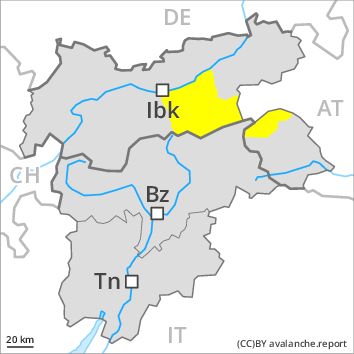
Danger level
Danger Level 2 - Moderate above the treeline
Danger Level 2 - Moderate above the treeline
Avalanche Problem
Wind-drifted snow above the treeline, N-NE-E-SE-S-SW-W-NW
Persistent weak layer above 2200m

The fresh and somewhat older wind slabs represent the main danger.
As a consequence of fresh snow and wind the wind slabs have increased in size additionally in the last three days. On wind-loaded slopes a considerable danger of dry avalanches will be encountered in some localities. The avalanche-prone wind slabs of the last three days can be released by a single winter sport participant in some cases in all aspects above the tree line. This applies in particular at their margins. They can also be released in the old snowpack and reach medium size in isolated cases especially on shady slopes.
Snowpack
dp 6: cold, loose snow and wind
dp 1: deep persistent weak layer
Over a wide area 10 to 20 cm of snow, and even more in some localities, fell in all altitude zones. The northerly wind has transported the fresh and old snow. Over a wide area avalanche prone wind slabs formed. The fresh snow and wind slabs of the last three days will be deposited on the unfavourable surface of an old snowpack in particular on shady slopes above the tree line. Faceted weak layers exist in the snowpack in particular here.
Tendency
Gradual decrease in avalanche danger as the snowfall eases.
Regions
Brandenberg Alps, Western Kitzbühel Alps, Wilder Kaiser Mountains - Waidring Alps, Eastern Kitzbühel Alps
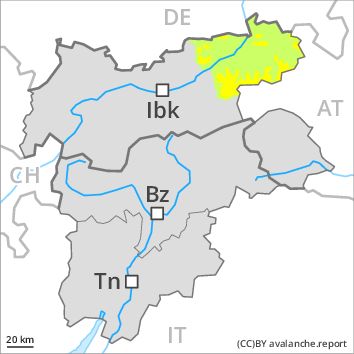
Danger level
Danger Level 2 - Moderate above the treeline
Danger Level 1 - Low above the treeline
Avalanche Problem
Wind-drifted snow above the treeline, N-NE-E-SE-S-SW-W-NW

The fresh and somewhat older wind slabs represent the main danger.
As a consequence of fresh snow and wind the wind slabs have increased in size additionally in the last three days. On wind-loaded slopes a moderate danger of dry avalanches will be encountered in some localities. The avalanche-prone wind slabs of the last three days can be released by a single winter sport participant in some cases in all aspects above the tree line. This applies in particular at their margins. Dry avalanches can reach medium size in isolated cases especially on shady slopes.
Snowpack
dp 6: cold, loose snow and wind
Over a wide area 10 to 20 cm of snow, and even more in some localities, fell in all altitude zones. The northerly wind has transported the fresh and old snow. Over a wide area avalanche prone wind slabs formed. The fresh snow and wind slabs of the last three days are bonding only slowly with the old snowpack in all aspects above the tree line.
Tendency
Gradual decrease in avalanche danger as the snowfall eases.
Regions
Latemar, Southern Adamello, Primiero - Pale di S. Martino, Adamello - Presanella, Prealps, Northern Brenta - Peller, Cembra Valley, Bondone and Stivo, Vallarsa, Western Nonsberg Alps, Folgaria - Laverone, Southern Brenta, Fassa Valley, Sole, Pejo and Rabbi, Southern Lagorai, Ledro Valley, Northern Lagorai, Maddalene, Paganella, Marzola - Valsugana, Pine' - Mocheni Valley
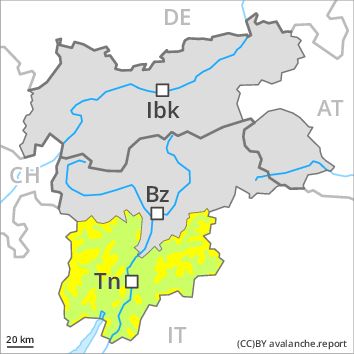
Danger level
Danger Level 2 - Moderate above the treeline
Danger Level 1 - Low above the treeline
Avalanche Problem
Wind-drifted snow above the treeline, N-NE-E-SE-S-SW-W-NW
Gliding snow above the treeline, N-NE-E-SE-S-SW-W-NW

The fresh wind slabs can be released easily.
The avalanche prone locations are to be found especially on wind-loaded slopes. In particular in the vicinity of peaks the wind slabs have increased in size in the last two days. The mostly small wind slabs can be released easily, even by a single winter sport participant, in all aspects. Dry slab avalanches are possible. These can in isolated cases be released in near-surface layers of the snowpack and reach medium size.
Snowpack
The strong wind has transported the fresh snow and, in some cases, old snow as well. Over a wide area easily released wind slabs formed. The fresh snow and wind slabs of Saturday are lying on the unfavourable surface of an old snowpack in particular on shady slopes. Faceted weak layers exist in the snowpack in particular here. Apart from the danger of being buried, restraint should be exercised as well in view of the danger of avalanches sweeping people along and giving rise to falls.
Tendency
Wind slabs represent the main danger.
Regions
Sexten Dolomites, Val Müstair Alps, Langtaufers, Schnals Ridge, Southern Stubai Alps, Southern Zillertal Alps and High Tauern, Saldurn-Mastaun Ridge, Texel Mountains, Sarntal Alps, Western Pfunderer Mountains, Eastern Pfunderer Mountains, Durreck Range, Western Rieserferner Mountains, Western Deferegger Alps, Ortler Range, Ulten Valley, Eastern Nonsberger Alps, Eastern Rieserferner Mountains, Northern Dolomites of Fiemme, Glockner Range, Gröden Dolomites, Eastern Deferegger Alps, Prags Dolomites, Schober Mountains, Lienzer Dolomites
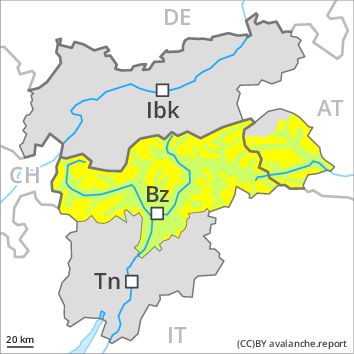
Danger level
Danger Level 2 - Moderate above the treeline
Danger Level 1 - Low above the treeline
Avalanche Problem
Wind-drifted snow above the treeline, N-NE-E-SE-S-NW

Wind slabs.
The fresh snow and wind slabs of Saturday can be released very easily. The rather small wind slabs can be released easily, even by a single winter sport participant, especially on northeast to north to south facing aspects above the tree line. Especially wind-loaded slopes where hard layers are lying on a weakly bonded old snowpack are critical. Individual dry slab avalanches are possible. These can in isolated cases be released in near-surface layers of the snowpack and reach quite a large size.
Snowpack
Over a wide area easily released wind slabs formed. The fresh snow and wind slabs of Saturday are lying on the unfavourable surface of an old snowpack in particular on shady slopes. Faceted weak layers exist in the snowpack in particular here. Apart from the danger of being buried, restraint should be exercised as well in view of the danger of avalanches sweeping people along and giving rise to falls. The fresh snow and wind slabs of Saturday are bonding only slowly with the old snowpack.
Tendency
Fresh wind slabs are to be evaluated with care and prudence.





